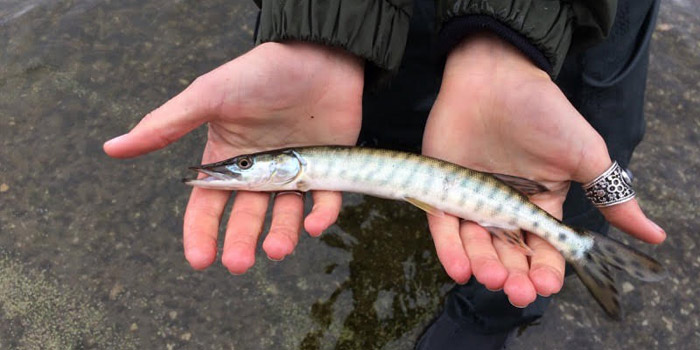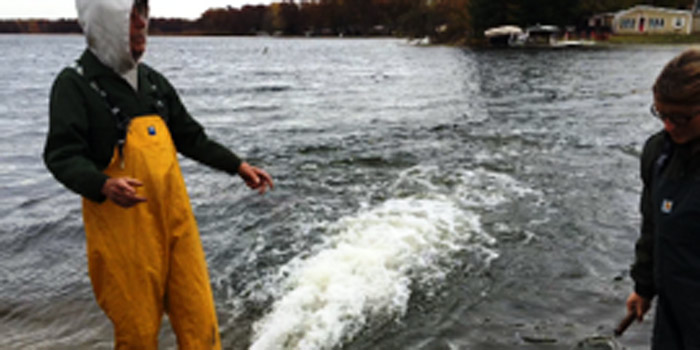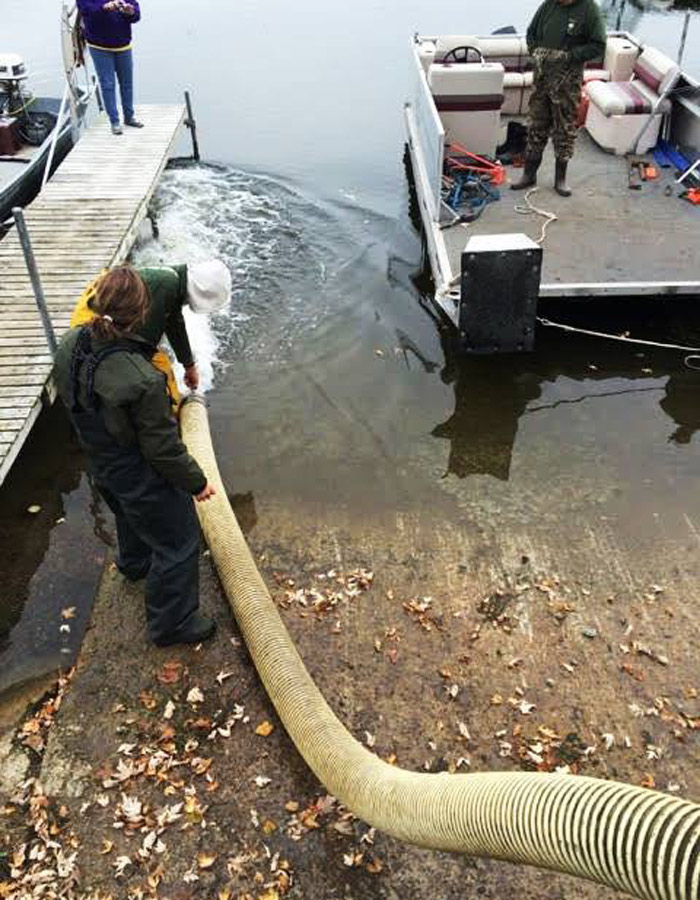Annual Muskie Release Goes Swimmingly
By EILEEN OAKS
Marketing and Outreach Specialist, Tippecanoe Watershed Foundation
KOSCIUSKO COUNTY — The 2,300 muskellunge fingerlings released into Backwater and Webster Lake last week seemed to have little in common with their reputation as one of the fiercest and most evasive challenges for anglers in the Midwest. In five years though, the ones that survive will be entitled to their moniker as ”The Fish of 10,000 Casts.”
 Jed Pearson, DNR fisheries biologist, has been in charge of releasing Muskie into Webster, Barbee and Tippecanoe lakes since 1981. The decision to stock the fish in these lakes came after numerous requests from fishing enthusiasts, who were tired of driving to Michigan to find their favorite fish.
Jed Pearson, DNR fisheries biologist, has been in charge of releasing Muskie into Webster, Barbee and Tippecanoe lakes since 1981. The decision to stock the fish in these lakes came after numerous requests from fishing enthusiasts, who were tired of driving to Michigan to find their favorite fish.
After checking Webster Lake’s water quality, current fish populations and types and plant cover, the DNR decided that it would be a prime location for a Muskie lake.
The Webster Lake Conservation Association, along with passionate fisherman, began stocking the lake in the late ’70s. They bought the Muskie from private hatcheries and with permission from the DNR, released the Muskie into the lake.
The DNR took over the operations in the mid-1980s, harvesting the Muskie eggs from Webster and raising them in their hatcheries for the next season. The DNR decided that a healthy Muskie level for Webster Lake would be five fish per acre, and they have worked to maintain these numbers. The 774-acre lake draws anglers from throughout the Midwest and supports several guide businesses.
 After seeing the success on Webster, other lakes in the area soon expressed an interest in stocking their lakes with Muskie. The Barbee Chain of Lakes and Lake Tippecanoe now have diversified their fishing options by adding this prehistoric-looking fish to their mix as well. The largest Muskie caught in the area was in Barbee Lake, and was over 51 inches in length. Pearson thinks that a fish that large was most likely a female, and well over 15 years old. Interestingly, male Muskie usually grows slower, and do not get as large as their female counterparts.
After seeing the success on Webster, other lakes in the area soon expressed an interest in stocking their lakes with Muskie. The Barbee Chain of Lakes and Lake Tippecanoe now have diversified their fishing options by adding this prehistoric-looking fish to their mix as well. The largest Muskie caught in the area was in Barbee Lake, and was over 51 inches in length. Pearson thinks that a fish that large was most likely a female, and well over 15 years old. Interestingly, male Muskie usually grows slower, and do not get as large as their female counterparts.
If you are interested in State Records, Darrin Conley caught a 42-pound, 8-ounce Muskie in Little Tippy in 2002. The size of the Muskie in these lakes is in part due to the catch and release tradition of Muskie fishing. The thrill of the chase is usually the main motivation for serious fisherman, so it is not uncommon for the same fish to be caught multiple times.
The Muskie fishing industry in North Webster is not only beneficial to the fisherman, but also to the community. The Muskie stocking has no adverse effects on the lakes, and Pearson concludes that of the $50,000 spent on state-wide hatchery operations, the economic value in this area alone is well over $450,000 dollars a year.
 In the past five years however, the fishing community has been alarmed with the survival of the muskies released in the lakes. While this decrease in fish populations is concerning, Pearson and his team are working on increasing the survival rate of the fish by trying new hatchery and release techniques.
In the past five years however, the fishing community has been alarmed with the survival of the muskies released in the lakes. While this decrease in fish populations is concerning, Pearson and his team are working on increasing the survival rate of the fish by trying new hatchery and release techniques.
This year, one change is that they are staggering the fish stocked. The fisheries biologists released 2,300 fish into Backwater and Webster Lake last Wednesday, and they will release the next 1,500 in the spring. Pearson hopes that the ones in the spring may have a better chance of survival. To test his hypothesis, he is installing PIT tags in the fish released this spring and next fall, to test their survival rates. He will monitor the fish for the next 10 years to compare the two groups.
Size limitations are also a new conservation strategy in Webster Lake. This year, the limit for keeping a Muskie in Webster has gone from 36 inches, to 44 inches. It remains 36 inches in Tippy and Barbee.
Hopefully these strategies have a long-term positive effect on the Muskie populations in Webster Lake. The Watershed Foundation is not directly involved with the Muskie release, but seeing how people enjoy the lakes is one of the motivations for the projects facilitated by TWF to ensure healthy water for today, and the future.
